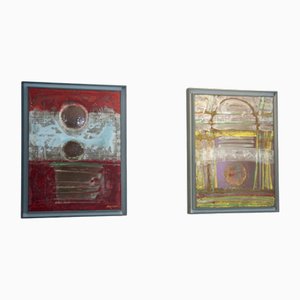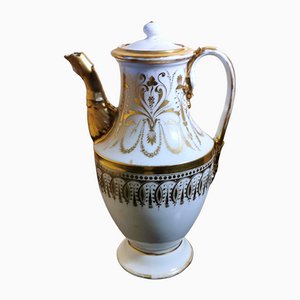We kindly invite you to read the entire , as we strive to provide you with detailed technical and historical information to ensure the authenticity of our items.This piece is an oil painting on canvas, created using a mixed technique of brush and palette knife. The artist initially used traditional brushes, then decisively transitioned to the palette knife technique, applying the colors thickly and consistently, giving the painting a distinctive texture and depth. with its geometric composition, vibrant colors, and abstract approach, this work can be attributed to the movement of geometric abstraction. In geometric abstraction, also known as "Concrete Art," the emphasis is on geometric forms, representing a return to fundamental geometric lines and the use of primary colors: yellow, blue, and red. This artistic movement primarily developed in the 20th century, inspired by Cubism and the works of artists such as Paul Klee and Wassily Kandinsky.The painting appears to explore simple geometric shapes in combination with colors that create strong visual contrast. The interplay of shapes, symbols, and colors also suggests an influence of Symbolist art, which aims to transcend visible reality to express deeper concepts. Regarding its era, we can confidently estimate that this painting dates to the second half of the 20th century, a period during which abstractionism and geometrism were widely experimented with by artists, particularly in Eastern and Western Europe. The mixed media technique of oil and tempera on canvas is characteristic of this period, when artists enjoyed combining materials to create more complex visual effects.On the back of the painting is an inscription in Bulgarian. The text "Пътят към звездите" translates to "The Path to the Stars," which might suggest a deeper or symbolic meaning, possibly related to aspiration, discovery, or transcendence. Also inscribed on the back is the name "СТЕЛИ," which is most likely the artist's name. "Стели" (Steli) is a Slavic name, possibly a diminutive or variation of the artist's full name. Given the use of Cyrillic and the Bulgarian language in the painting's title, it is reasonable to assume that the artist is of Bulgarian origin. The French translation on the back, "Stelly," further supports this assumption. However, we are unable to provide definitive information about the artist's identity. Abstract painting in Bulgaria developed significantly in the second half of the 20th century, following the general influence of modernist and abstract movements that spread across Europe after World War II. While Western European countries saw the rise of the abstractionist movement as early as the 1910s and 1920s, in Bulgaria, its spread came later, largely due to the political conditions imposed by the communist regime, which favored realist and ideologically aligned art. In the 1960s, Bulgaria began to show greater openness to modern art, and it was during this time that the abstractionist movement started to develop more fully. This was partly due to increased exposure of Bulgarian artists to international artistic trends and opportunities to participate in international exhibitions, although restrictions under the regime made it challenging for avant-garde art to be fully expressed. Of this painting, we can affirm its extraordinary aesthetics and captivating vibrancy. It is a work that, with its joyful freshness and strong decorative appeal, lends itself well to enhancing any room in the home. The painting was intentionally created without a frame; the canvas is affixed to a solid wooden support, the back of which is entirely covered with paper. The painting is in excellent condition. Dimensions: Width 70 cm, height 70 cm, depth 3 cm.
Vi invitiamo a leggere l'intero documento, in quanto ci impegniamo a fornire informazioni tecniche e storiche dettagliate per garantire l'autenticità dei nostri articoli.Questo pezzo è un dipinto a olio su tela, realizzato con una tecnica mista di pennello e spatola. L'artista ha inizialmente utilizzato pennelli tradizionali, per poi passare con decisione alla tecnica della spatola, applicando i colori in modo denso e costante, conferendo al dipinto una consistenza e una profondità distintive. Con la sua composizione geometrica, i colori vivaci e l'approccio astratto, quest'opera può essere attribuita al movimento dell'astrazione geometrica. Nell'astrazione geometrica, nota anche come "Arte concreta", l'enfasi è posta sulle forme geometriche, che rappresentano un ritorno alle linee geometriche fondamentali e all'uso dei colori primari: giallo, blu e rosso. Questo movimento artistico si è sviluppato principalmente nel XX secolo, ispirato al cubismo e alle opere di artisti come Paul Klee e Wassily Kandinsky. La pittura sembra esplorare forme geometriche semplici in combinazione con colori che creano un forte contrasto visivo. Il gioco di forme, simboli e colori suggerisce anche un'influenza dell'arte simbolista, che mira a trascendere la realtà visibile per esprimere concetti più profondi. Per quanto riguarda l'epoca, possiamo stimare con certezza che questo dipinto risalga alla seconda metà del XX secolo, periodo in cui l'astrattismo e il geometrismo furono ampiamente sperimentati dagli artisti, in particolare nell'Europa orientale e occidentale. La tecnica mista di olio e tempera su tela è caratteristica di questo periodo, in cui gli artisti si divertivano a combinare i materiali per creare effetti visivi più complessi.Sul retro del dipinto si trova un'iscrizione in bulgaro. Il testo "Пътят към звездите" si traduce in "Il cammino verso le stelle", che potrebbe suggerire un significato più profondo o simbolico, forse legato all'aspirazione, alla scoperta o alla trascendenza. Sul retro è inciso anche il nome "СТЕЛИ", che molto probabilmente è il nome dell'artista. "Стели" (Steli) è un nome slavo, forse un diminutivo o una variante del nome completo dell'artista. Dato l'uso del cirillico e della lingua bulgara nel titolo del dipinto, è ragionevole supporre che l'artista sia di origine bulgara. La traduzione in francese sul retro, "Stelly", avvalora ulteriormente questa ipotesi. Tuttavia, non siamo in grado di fornire informazioni definitive sull'identità dell'artista. La pittura astratta in Bulgaria si è sviluppata in modo significativo nella seconda metà del XX secolo, seguendo l'influenza generale dei movimenti modernisti e astratti che si sono diffusi in Europa dopo la seconda guerra mondiale. Mentre i Paesi dell'Europa occidentale hanno visto l'ascesa del movimento astrattista già negli anni Dieci e Venti del Novecento, in Bulgaria la sua diffusione è avvenuta più tardi, soprattutto a causa delle condizioni politiche imposte dal regime comunista, che privilegiava un'arte realista e ideologicamente allineata. Negli anni Sessanta, la Bulgaria iniziò a mostrare una maggiore apertura verso l'arte moderna e fu in questo periodo che il movimento astrattista iniziò a svilupparsi in modo più completo. Ciò fu in parte dovuto alla maggiore esposizione degli artisti bulgari alle tendenze artistiche internazionali e alle opportunità di partecipare a mostre internazionali, sebbene le restrizioni imposte dal regime rendessero difficile la piena espressione dell'arte d'avanguardia. Di questo dipinto possiamo affermare la straordinaria estetica e l'accattivante vivacità. È un'opera che, con la sua gioiosa freschezza e il suo forte appeal decorativo, si presta a valorizzare qualsiasi ambiente della casa. Il dipinto è stato volutamente realizzato senza cornice; la tela è fissata su un solido supporto di legno, il cui retro è interamente rivestito di carta. Il dipinto è in ottime condizioni. Dimensioni: Larghezza 70 cm, altezza 70 cm, profondità 3 cm.
























Contattaci
Fai un'offerta
Abbiamo notato che sei nuovo su Pamono!
Accetta i Termini e condizioni e l'Informativa sulla privacy
Contattaci
Fai un'offerta
Ci siamo quasi!
Per seguire la conversazione sulla piattaforma, si prega di completare la registrazione. Per procedere con la tua offerta sulla piattaforma, ti preghiamo di completare la registrazione.Successo
Grazie per la vostra richiesta, qualcuno del nostro team vi contatterà a breve.
Se sei un professionista del design, fai domanda qui per i vantaggi del Programma Commerciale di Pamono